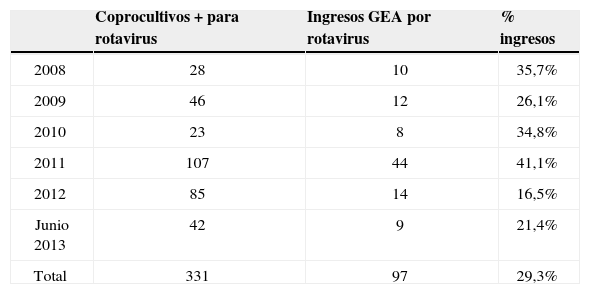Conocer la carga de enfermedad asociada a gastroenteritis aguda (GEA) por rotavirus en la población infantil (menores de 5años) de la provincia de Salamanca, específicamente en enfermedad grave (ingresos hospitalarios), y estimar los beneficios de la inclusión de la vacunación frente a rotavirus en el calendario vacunal infantil, ya que actualmente no está financiada por el sistema sanitario.
MétodosEstudio observacional retrospectivo de los ingresos hospitalarios en menores de 5años, entre el 1 de enero de 2008 y el 30 de junio de 2013, por GEA por rotavirus. Fuente de datos: CMBD y Laboratorio de Microbiología del Complejo Asistencial Universitario de Salamanca.
ResultadosLas GEA por rotavirus representaron el 64,2% (97 casos) de los ingresos por GEA infecciosas en niños menores de 5años (tasa de ingresos 10,4/1.000 altas), siendo más frecuente en el grupo de 6meses a un año. Se observó un incremento de las hospitalizaciones en el año 2011 (tasa 28,2/1.000 altas), año posterior a la interrupción de la comercialización en España de la vacuna frente a rotavirus.
ConclusionesLos datos obtenidos sugieren que sería beneficiosa la inclusión de la vacuna frente a rotavirus en el calendario vacunal infantil, especialmente en los grupos de menor edad, donde se evitarían los casos graves.
To determine the burden of disease associated with rotavirus acute gastroenteritis in children under 5years in the province of Salamanca, specifically in severe illness (hospitalization) and estimate the benefits of the inclusion of rotavirus vaccine in the childhood immunization schedule, vaccine, at present, not financed by the health system.
MethodsRetrospective observational study of the hospital admissions for rotavirus gastroenteritis in children under 5 years, between January 1, 2008 and June 30, 2013. Data source: CMBD and Microbiology Laboratory of University Hospital. Salamanca.
ResultsRotavirus gastroenteritis accounted for 64.2% (97 cases) of the admissions for infectious gastroenteritis in children under 5years (rate of admissions 10.4/1,000 discharges), being more frequent in the group of 6months to 1year. Increased hospitalization is observed in 2011 (rate 28.2/1,000 discharges), year after the interruption of distribution in Spain of the rotavirus vaccine.
ConclusionsThe obtained data suggests that it would be beneficial to include the rotavirus vaccine in the childhood immunization schedule, specially in younger age groups, in which, the most serious cases would be avoided.
Artículo
Comprando el artículo el PDF del mismo podrá ser descargado
Precio 19,34 €
Comprar ahora









